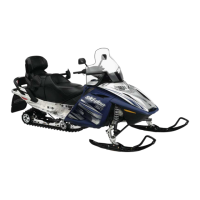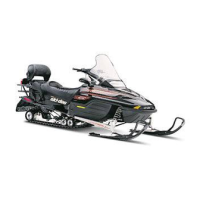Section 03 TROUBLESHOOTING
Sub-Section 03 (TRANSMISSION AND BRAKE SYSTEM)
03-03-1
TRANSMISSION
AND BRAKE SYSTEM 3
The following charts are provided to help in diagnosing the probable source of troubles. It should be used
as a guideline. Some causes or corrections may not apply to a specific model.
TRANSMISSION
SYMPTOM THE SNOWMOBILE ACCELERATES SLOWLY, ESPECIALLY WHEN IT IS STOPPED.
CONDITION NORMAL USE.
Test / Inspection 1. Check drive belt condition.
a. Belt is too narrow (drive belt engagement is higher in drive pulley).
Replace belt if width is 3 mm (1/8”) less than a new one (refer to TECHNICAL
DATA 10).
2. Check distance between pulleys and / or drive belt deflection.
a. Distance is too small between pulleys or deflection is too high (drive belt engage-
ment is higher in drive pulley).
Adjust distance between pulleys and / or drive belt deflection according to specifi-
cations (refer to TECHNICAL DATA 10).
3. Check driven pulley sliding half play.
a. Jammed sliding half.
Replace.
4. Check spring tension of driven pulley sliding half.
a. Sliding half rotation is accelerated when spring tension is too weak.
Adjust according to specifications (refer to TECHNICAL DATA 10).
5. Refer to “Vibrations originating from driven pulley” and check items listed.
6. Check drive pulley spring tension.
a. Spring tension is too weak.
Replace.
SYMPTOM ENGINE MAXIMUM RPM IS TOO HIGH AND TOP SPEED IS NOT REACHED.
CONDITION NORMAL USE.
Test / Inspection 1. Check items 1, 2 and 3 of “The snowmobile accelerates slowly, especially when it
is stopped”.
2. Check driven pulley spring tension.
a. Spring tension is to stiff.
Adjust according to specification (refer to TECHNICAL DATA 10).
3. Check position of the calibration screws. (TRA drive pulley)
a. Selected numbers are too high.
Adjust according to specification (refer to TECHNICAL DATA 10).
4. Refer to “Vibrations originating from driven pulley” and check items listed.

